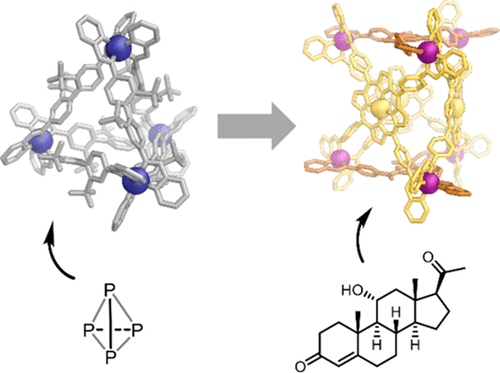当前位置:
X-MOL 学术
›
Chem. Rev.
›
论文详情
Our official English website, www.x-mol.net, welcomes your
feedback! (Note: you will need to create a separate account there.)
Beyond Platonic: How to Build Metal–Organic Polyhedra Capable of Binding Low-Symmetry, Information-Rich Molecular Cargoes
Chemical Reviews ( IF 51.4 ) Pub Date : 2022-04-18 , DOI: 10.1021/acs.chemrev.1c00763 Charlie T McTernan 1 , Jack A Davies 1 , Jonathan R Nitschke 1
Chemical Reviews ( IF 51.4 ) Pub Date : 2022-04-18 , DOI: 10.1021/acs.chemrev.1c00763 Charlie T McTernan 1 , Jack A Davies 1 , Jonathan R Nitschke 1
Affiliation

|
The field of metallosupramolecular chemistry has advanced rapidly in recent years. Much work in this area has focused on the formation of hollow self-assembled metal-organic architectures and exploration of the applications of their confined nanospaces. These discrete, soluble structures incorporate metal ions as ‘glue’ to link organic ligands together into polyhedra.Most of the architectures employed thus far have been highly symmetrical, as these have been the easiest to prepare. Such high-symmetry structures contain pseudospherical cavities, and so typically bind roughly spherical guests. Biomolecules and high-value synthetic compounds are rarely isotropic, highly-symmetrical species. To bind, sense, separate, and transform such substrates, new, lower-symmetry, metal-organic cages are needed. Herein we summarize recent approaches, which taken together form the first draft of a handbook for the design of higher-complexity, lower-symmetry, self-assembled metal-organic architectures.
中文翻译:

超越柏拉图式:如何构建能够结合低对称性、信息丰富的分子货物的金属有机多面体
近年来,金属超分子化学领域发展迅速。该领域的许多工作都集中在中空自组装金属有机结构的形成以及对其有限纳米空间的应用的探索。这些离散的可溶结构将金属离子作为“胶水”将有机配体连接在一起形成多面体。迄今为止采用的大多数结构都是高度对称的,因为它们是最容易制备的。这种高度对称的结构包含伪球形空腔,因此通常结合大致球形的客体。生物分子和高价值合成化合物很少是各向同性、高度对称的物种。为了结合、感知、分离和转化这些底物,需要新的、低对称性的金属有机笼。在这里,我们总结了最新的方法,这些方法共同构成了设计更高复杂性、更低对称性、自组装金属有机结构的手册的初稿。
更新日期:2022-04-18
中文翻译:

超越柏拉图式:如何构建能够结合低对称性、信息丰富的分子货物的金属有机多面体
近年来,金属超分子化学领域发展迅速。该领域的许多工作都集中在中空自组装金属有机结构的形成以及对其有限纳米空间的应用的探索。这些离散的可溶结构将金属离子作为“胶水”将有机配体连接在一起形成多面体。迄今为止采用的大多数结构都是高度对称的,因为它们是最容易制备的。这种高度对称的结构包含伪球形空腔,因此通常结合大致球形的客体。生物分子和高价值合成化合物很少是各向同性、高度对称的物种。为了结合、感知、分离和转化这些底物,需要新的、低对称性的金属有机笼。在这里,我们总结了最新的方法,这些方法共同构成了设计更高复杂性、更低对称性、自组装金属有机结构的手册的初稿。











































 京公网安备 11010802027423号
京公网安备 11010802027423号